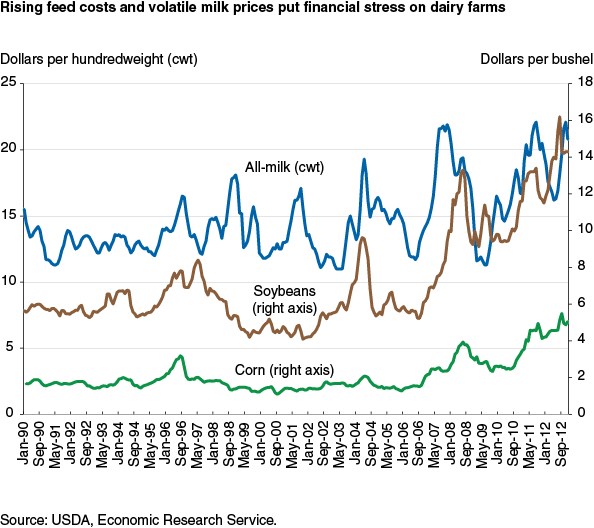Livestock Gross Margin-Dairy—an Effective Risk Management Tool?
- by Donald Blayney and Roberto Mosheim
- 3/4/2014
Until recently, long-standing dairy policies and programs have generally tempered the impacts of milk price declines on dairy farmers. However, greater milk price volatility combined with rising input costs has reduced the effectiveness of these policies. As early as 2010, ideas for changes to existing dairy policies were discussed, including a new policy to protect the farmer’s margin between farm-level milk prices and feed input costs, but there was little discussion of an existing program with the same objective, called Livestock Gross Margin-Dairy (LGM-Dairy), which was initiated in August 2008.
LGM-Dairy is a small risk management program, overseen by USDA’s Risk Management Agency. Unlike commonly used risk management tools such as futures and options that rely on individual price expectations, LGM-Dairy focuses on the margin between milk prices and input costs. Under the program, individual producers purchase margin insurance based on their assessments of the probability and dollar amount of possible margin losses. LGM-Dairy is available through local insurance agents and is offered in scales appropriate for small- and medium-sized dairies.
LGM-Dairy was introduced during a period of increased market volatility and was thus an appealing risk management tool. However, program funding was just $20 million for all of the livestock insurance programs established by legislation. The limited funding prevented producers from using LGM-Dairy as a year-round risk management strategy. Still, understanding the effects of its use is helpful for assessing a margin insurance program that might be included in future farm legislation.
ERS and University of Kentucky researchers constructed a model of LGM-Dairy based on a monthly gross margin defined as the milk price minus feed costs for 13 regions. Margins for the January 2001 to April 2011 time period were derived using monthly cash and futures prices for milk, corn, and soybean meal. Researchers defined a measure of risk, and simulations were conducted on hypothetical representative farms to estimate the extent to which risk was reduced for farms using LGM-Dairy.
Results indicated that LGM-Dairy could reduce risk by 28 to 39 percent across all regions evaluated. The program had little effect on the size of the average margin, which ranged from -1 to 2 percent. The simulated effects also indicated that LGM-Dairy adoption provides only modest incentives to expand production; supply response ranged from no expansion to a 3-percent increase. The results suggest LGM-Dairy use produces similar risk management performance across all regions.
This article is drawn from:
- Burdine, K.H., Mosheim, R., Blayney, D. & Maynard, L. (2014). Livestock Gross Margin-Dairy Insurance: An Assessment of Risk Management and Potential Supply Impacts. U.S. Department of Agriculture, Economic Research Service. ERR-163.



